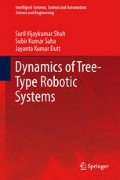Abstract
As frequently noted in the literature on robotics (Sugihara et al. 2002; Kurazume et al. 2003; Vukobratovic et al. 2007; Kwon and Park 2009) and mechanisms (Duffy 1978; Chaudhary and Saha 2007), a higher Degrees-of-Freedom (DOF) joint, say, a universal, a cylindrical or a spherical joint, can be represented using a combination of several intersecting 1-DOF joints. For example, a universal joint also known as Hooke’s joint is a combination of two revolute joints, the axes of which intersect at a point, whereas a cylindrical joint is a combination of a revolute joint and a prismatic joint. Similarly, the kinematic behavior of a spherical joint may be simulated by the combination of three revolute joints whose axes intersect at a point. The joint axes can be represented using the popular Denavit and Hartenberg (DH) parameters (Denavit and Hartenberg 1955). For the spherical joints, an alternative approach using the Euler angles can also be adopted, as there are three variables. For spatial rotations, one may also use other minimal set representations like Bryant (or Cardan) angles, Rodriguez parameters, etc. or non-minimal set representation like Euler parameters, quaternion, etc. The non-minimal sets are not considered here due the fact that the dynamic models obtained in this book are desired in minimal sets. The minimal sets, other than Euler/Bryant angles, are discarded here as they do not have direct correlation with the axis-wise rotations. It is worth mentioning that the fundamental difference between the Euler and Bryant angles lies in a fact that the former represents a sequence of rotations about the same axis separated with a rotation about a different axis, denoted as α–β–α, whereas the latter represents the sequence of rotations about three different axes, denoted as α–β–γ. They are also commonly referred to as symmetric and asymmetric sets of Euler angles in the literature. For convenience, the name Euler angles will be referred to both Euler and Bryant angles, hereafter.
Access this chapter
Tax calculation will be finalised at checkout
Purchases are for personal use only
References
Chaudhary, H., & Saha, S. K. (2007). Constraint wrench formulation for closed-loop systems using Two-level recursions. ASME Journal of Mechanical Design, 129, 1234–1242.
Craig, J. J. (2006). Introduction to robotics, mechanics and control. Delhi: Pearson Education.
Denavit, J., & Hartenberg, R. S. (1955). A kinematic notation for lower-pair mechanisms based on matrices. Journal of Applied Mechanics, 22, 215–221.
Duffy, J. (1978). Displacement analysis of the generalized RSSR mechanism. Mechanism and Machine Theory, 13, 533–541.
Khalil, W., & Kleinfinger, J. (1986). A new geometric notation for open and closed-loop robots. IEEE International Conference on Robotics and Automation, 3, 1174–1179.
Kurazume, R., Hasegawa, T., & Yoneda, K. (2003). The sway compensation trajectory for a biped robot. IEEE International Conference on Robotics and Automation, 1, 925–931.
Kwon, O., & Park, J. H. (2009). Asymmetric trajectory generation and impedance control for running of biped robots. Autonomous Robots, 26(1), 47–78.
Shabana, A. A. (2001). Computational dynamics. New York: Wiley.
Shah, S. V., Saha, S. K., & Dutt, J. K. (2012b). Denavit-Hartenberg (DH) Parametrization of Euler Angles. ASME J of Nonlinear and Computational Dynamics, 7(2).
Shuster, M. D., & Oh, S. D. (1981). Three-axis attitude determination from vector observation. Journal of Guidance, Control and Dynamics, 4(1), 70–77.
Singla, P., Mortari, D., & Junkins, J. L. (2004). How to avoid singularity for Euler Angle Set?. AAS space flight mechanics conference, Hawaii.
Sugihara, T., Nakamura, Y., & Inoue, H. (2002). Realtime Humanoid motion generation through ZMP manipulation based on inverted pendulum control. IEEE International Conference on Robotics and Automation, 2, 1404–1409.
Vukobratovic, M., Potkonjak, V., Babkovic, K., & Borovac, B. (2007). Simulation model of general human and humanoid motion. Multibody System Dynamics, 17(1), 71–96.
Wittenburg, J. (2008). Dynamics of multibody systems. Berlin: Sprnger.
Author information
Authors and Affiliations
Rights and permissions
Copyright information
© 2013 Springer Science+Business Media Dordrecht
About this chapter
Cite this chapter
Shah, S.V., Saha, S.K., Dutt, J.K. (2013). Euler-Angle-Joints (EAJs). In: Dynamics of Tree-Type Robotic Systems. Intelligent Systems, Control and Automation: Science and Engineering, vol 62. Springer, Dordrecht. https://doi.org/10.1007/978-94-007-5006-7_3
Download citation
DOI: https://doi.org/10.1007/978-94-007-5006-7_3
Published:
Publisher Name: Springer, Dordrecht
Print ISBN: 978-94-007-5005-0
Online ISBN: 978-94-007-5006-7
eBook Packages: EngineeringEngineering (R0)

